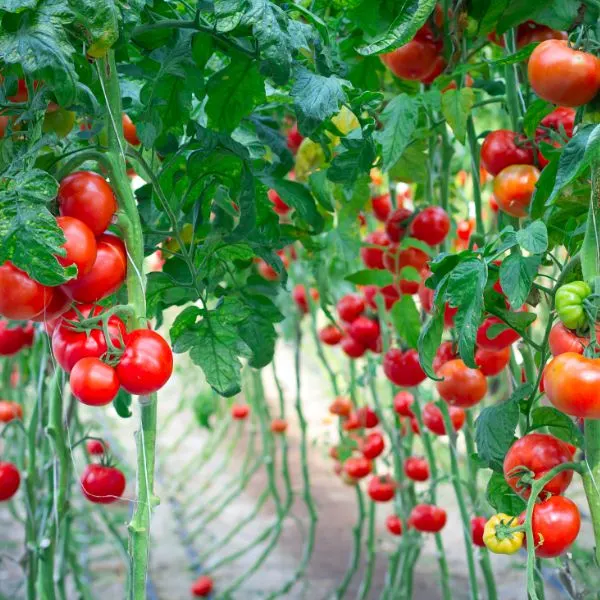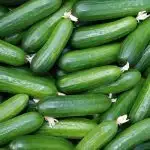Companion planting may be one of the new buzzwords, but it isn’t a new concept at all. People have been utilizing companion planting since gardening began. Just with the invention of farming equipment and huge farms, it was easier to plant an entire field of a single plant than it was to intersperse several vegetables together.
In Native American lore, the tale of the three sisters refers to corn, squash, and beans growing together. Corn provides the framework for bean vines to climb, while the beans pull nitrogen from deep in the soil for the corn. Squash plants benefit both corn and beans by acting as a natural mulch, keeping the soil cool and damp, and warding off deer.
There are also plenty of garden plants that absolutely do not work together. Beans and onions should not be placed near each other because the beans can prohibit the growth of the allium family. Tomatoes and potatoes should not be grown together, they are from the same family and will compete for nutrients, so both plants will inevitably suffer.
There’s a lot of information out there about cucumbers and tomatoes growing together. Some say they are great companions, while many others say they should be far apart, so what’s the real deal?
The fact is, cucumbers and tomatoes can coexist together, but there are definitely better companions for them both. We’ll go into both reasons they do and don’t work together in this article, and then you can make the decision for yourself.
Table of Contents
How Cucumbers and Tomatoes Can Work Together

For these plants to work together you need a bush type of one and a vine of the other. Both cucumbers and tomatoes come in these two varieties. When you think of cucumbers you probably think of vines growing on a fence or large trellis with the cukes dangling off the sprawling vine.
You can grow these vines on the ground though, but it’s not recommended because the cucumbers can become curled if they are a long variety, become food for ground insects, or rot if the soil stays damp. If you are lacking the space for a trellis, you can go with bush varieties of cucumbers.
Some bush varieties of cucumbers include “bush champion,” “salad bush,” “spacemaster,” and “pot luck.” Most bush varieties only grow between 1 to 3 feet tall, but can still produce plenty of cucumbers.
Indeterminate, pole, or vining tomato plants will need more support than a typical tomato cage can provide, they need a trellis to climb. Keep an eye on the types of seeds you get, or talk to your local nursery personnel.
Dual Vining Veggies Are No Good
The problem with growing vining tomatoes and cucumbers together is they will compete for sunlight. They also won’t receive the proper amount of airflow. Both plants will suffer and you’ll get a limited harvest.
The same goes for bush varieties of tomatoes and cucumbers. As they grow, one will inevitably shade the other, resulting in mediocre plants.
Proper Spacing Required
For tomatoes and cucumbers to work together, you need proper spacing from each other. Typically they need about a foot to 18 inches between each other. And be sure to keep your bush plant in front of the vines so they still get plenty of sunlight, both these plants need full sunlight and heat to be healthy.
You’ll Need to Fertilize Regularly
Both cucumbers and tomatoes are known to be heavy feeders, and they both require basically the same nutrients. During the peak growing season, you’ll need to get a balanced fertilizer such as a 10-10-10. Make sure it’s organic and follow the instructions so you don’t overfeed them.
Without the fertilizer, these plants will suck the soil dry of nutrients and growth will drastically slow down.
Tomatoes Attract Beneficial Bugs
Certain varieties of cucumbers need pollination to produce succulent fruits. Many tomato plants are self pollinating, but they still attract bumblebees. These bees seem made for tomato flowers.
They can hang upside down on the flowers and shake pollen out of them for the tomato plants that need pollination. When the bees are finished with the tomatoes, they will then turn to the bigger cucumber flowers and pollinate them. This is another reason tomatoes and cucumbers can work together.
As you can see, tomatoes and cucumbers can live in close proximity to each other, you’ll just have to adjust a few things for both of these plants to be happy.
Why Should You Not Plant Cucumbers Near Tomatoes

Some reasons these plants work well together can be a reason they shouldn’t be planted in close proximity to each other. If you have a small garden space, these plants could compete for sunlight, there may not be enough airflow to keep them healthy, and as we mentioned before they can compete for nutrients.
Other reasons cucumbers and tomatoes don’t work great together is they both tend to be susceptible to the same diseases and insect pests. If your cucumbers come down with the cucumber mosaic virus, it can quickly spread to tomato plants.
Depending on varieties, water can be an issue too. Tomatoes often like to dry out a bit between waterings, but some cultivars of cucumbers need a lot of water to grow succulent fruits. They are around 90 to 96% water after all.
Let’s dive deeper into these reasons and more you may not want to put cucumbers and tomatoes together.
1. Cucumbers and Tomatoes Are Heavy Feeders
Tomatoes are considered relatively heavy feeders, but at the same time, too much nutrition in the soil can cause a lower production, and/or blossom end rot. If you are going for an organic garden, adding compost, fish meal, or worm castings is a great way to increase the vital nutrients in the soil, but it may not be enough for heavy feeders such as tomatoes and cucumbers.
You’ll have to keep an eye on both these plants and adjust the fertilizer as needed. If you were to plant bush beans or peas with your cucumbers, you wouldn’t have to fertilize as much because these plants are nitrogen fixers. This means they draw nitrogen out of the air as well as the soil and large bits in the dirt such as decaying wood chunks.
2. Disease Spreads Easily Between Tomatoes and Cucumbers

One of the biggest benefits of great companion planting is the reduction in contractible diseases and pests. Planting marigolds in the garden for instance is a great way to ward off aphids and many other insect pests that can wreak havoc.
The cucumber mosaic virus, as we already mentioned, can hop from one plant to the other. This is usually spread by aphids, which is a small, soft bodied insect that will eagerly feed on tomatoes and cucumbers. Ants often herd these insects like humans do cattle, and can spread them from plant to plant, especially if they are very close together.
This virus drains the nutrition from the plants and leaves highways of light yellow streaks throughout the plant. It will cause stunted growth, misshapen leaves and produce, and will eventually kill the plant.
Another disease that can affect both cucumbers and tomatoes is blight fungus. This fungal disease is passed by spores whisked away in the wind. When tomatoes and cucumbers are close together, this can quickly spread from one to the other.
Blight fungus looks like brown spots on the leaves and stems and will quickly spread to the tomatoes themselves. If it isn’t treated quickly, it can destroy the entire plant. It spreads readily to cucumber plants, so if one plant gets it, both types can quickly become infected and ruined.
Another fatal disease that affects both cucumbers and tomatoes is bacterial wilt. This is initially difficult to diagnose because the leaves will wilt during the daytime and then seem to recover at night. The leaves will yellow and then turn brown at the edges.
It may seem like the plant is having water issues, but the bacteria will quickly kill off cucumber plants. This bacteria is passed on by the striped cucumber beetle, which is a pest that feeds on both cucumbers and tomatoes, which leads us to the next reason these two plants might be better spaced further apart.
3. Insect Pests That Love Cucumbers and Tomatoes

Aside from the striped cucumber beetle, aphids also love both of these plants. Aphids hide on the undersides of leaves and slowly suck the fluids from the plant. Their sharp little suckers pierce the flesh and can introduce secondary infections.
Aphids spread very quickly and can take over certain plants seemingly overnight. Tomatoes, cabbage, kale, and other plants from the Brassica family are favorites of aphids. They will also readily spread to cucumbers, especially if you have ants anywhere near the garden.
The ants feed on the aphids’ honeydew excretions. This is a sweet, sticky, sap like substance the aphids drop as they feed. The honeydew can also cause sooty mold on your plants, so you’ll need to get rid of these insects as soon as possible.
Another voracious tomato and cucumber devourer is the tomato hornworm. The name is a bit of a misnomer because it’s actually a caterpillar. If you’re familiar with the children’s book The Very Hungry Caterpillar, I would venture to say it is based on the hornworm.
When this feeding machine hops onto a tomato plant, it can completely defoliate it in a day or two. When it’s left your tomato plant looking skeletonized, it will set about doing the same to your cucumber plant, or vice versa.
4. Plants Need Plenty of Airflow
Square foot gardening is becoming popular again, and so is utilizing every square inch of garden space without taking up miles of dirt. It just takes some prior planning or your garden won’t be as healthy as it could be.
Just like pruning your trees to maximize airflow between the branches keeps them healthy, keeping your garden veggies spaced will minimize problems. Cucumbers and tomatoes are often big, compact plants that need space for this airflow.
If you plant tomatoes and cucumbers close together the leaves and stems will get crowded. Not only will they not get enough sunlight, but the air between the stems and leaves is not able to properly dry out. This damp air can be a vector for fungus and disease.
Powdery mildew is one rampant problem among squash and cucumbers, that is often caused by overly damp soil or improper airflow. This fungus can also spread to tomatoes.
Another benefit to proper airflow in your garden is to help whisk with gas exchanges between the plants. Stale air can affect the plant and prevent it from growing the best. When planting cucumbers and tomatoes together, you really need at least 18 inches of space between them.
In small gardens, that’s actually a lot of unused real estate that something else could be occupying. So, while you can plant these two together, there are better plants that work together and take up less space.
5. Water Differences
Both of these plants love water and need a lot to keep the fruits plump, juicy, and tasty. The thing is, as cucumbers continue to grow larger, especially the vining types, they require more water to keep them healthy and producing well.
When cucumbers don’t get the proper amount of water they produce bitter, and sometimes woody cucumbers. While it’s difficult to put a proper number to how much water a single plant needs, the general rule of thumb for cucumbers is about 2 inches of water per week.
Tomatoes need a lot of water too. They benefit best when the soil is kept properly moist, or only the top of the dirt starts to dry out. Like most plants, they don’t do well with constantly soggy soil, but they generally require a little bit less water than cucumbers.
A general amount of water for tomato plants is about 1 inch of water per week. Of course, this changes depending on the soil type, tomato variety, weather, wind, evaporation rate, and how hot it is. Still, an established cucumber plant typically requires about twice as much water as tomatoes.
This can cause a problem with the tomato plant because excess water can cause root rot, or blossom end rot on the tomatoes. The end of the tomato where the blossom fell off will start to turn brown, then black, and will rot it from the bottom up.
Again, this is manageable if you keep the plants far enough away from each other, or focus your watering efforts accordingly. It could also mean more work and more to keep up with. Gardening can already be a lot of work, the last thing you want to do is add more to your already busy schedule.
FAQs
What can you not plant next to cucumbers?

Potatoes are deep growing heavy feeders that will compete with nutrients and water with the cucumber. If you dig them up before cucumbers are finished producing, you could damage the roots which cucumbers hate having their roots disturbed.
Sage, fennel, mint, and other strong smelling herbs are bad for cucumbers, with the exception of dill and oregano. These herbs can offset the flavor of cucumbers, and fennel produces a chemical that will inhibit the growth of cucumbers.
What should not be planted with tomatoes?

Keep other plants from the nightshade family such as potatoes, and eggplants away from tomato plants. They will compete vigorously for the same nutrients. Also don’t grow cabbage, broccoli, kale, or other brassica plants near tomatoes. They will stunt your tomato growth.
What happens if you don’t pick cucumbers?

When cucumbers are left on the vine they will get big, heavy, bitter, and possibly even woody, making them quite inedible. If you’re looking to keep a cucumber to store seeds for the next year, you can let one grow until it starts to dry out.
But you need to make sure you pollinate the flower yourself and then close it off, or you may end up with some kind of hybrid as cucumbers can cross pollinate with squash and some melons.
Can you plant tomatoes and cucumbers together?

Yes, tomatoes and cucumbers can be planted together as they have similar sunlight and watering needs as mentioned in this article.
Final Verdict
If you ask ten different gardeners if cucumbers and tomatoes grow well together, you’re likely to get at least 8 different answers. The truth is, they won’t harm or inhibit the growth of one another. Plants like black walnuts and sunflowers produce chemicals that keep most other plants from growing near them, but there is no such interaction between tomatoes and cucumbers.
Of course, they aren’t amazing companion plants either. If you want a great tomato companion plant, you will have a hard time beating basil.
As for cucumbers, the best companion plant(s) are probably beans or other legumes. Of course, dill works great with cucumbers too. I know pickles wouldn’t be the same without a lot of dill!
You can certainly plant cucumbers and tomatoes together if you want to, and if it turns out that’s the best way for you to grow your garden, then go ahead and do it that way. When growing these two plants together, it’s not a bad thing, but at the same time, there are other plants that could work better as companions.
Our final verdict here is cucumbers and tomatoes can actually grow together as companion plants, but there are a few caveats to be aware of. And there may be a little more work involved in keeping them both happy and healthy.
More cucumber stuff
